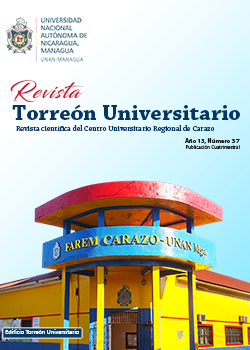Design of a financial analysis model to boost the profitability of MSMEs, Sivareña case study
DOI:
https://doi.org/10.5377/rtu.v13i37.17959Keywords:
Financial analysis, Costs, Fixed expenses, Contribution margin, Financial model, Small businesses, Break-even point, Unit price, ProfitabilityAbstract
This research aims to design a financial analysis model to boost the profitability of the small and medium-sized company, Sivareña, in whose development the product lines are evaluated, and the maximum growth gap as metrics to plan sales goals (gaps), associated with the financial profitability of the business. Likewise, a proposed financial model was implemented - a tool in Microsoft Excel, and the final result proposes price adjustments and strategies and adjustment of financial and market impact costs to boost the profitability of the company.
The work method has a mixed approach, combining quantitative and qualitative analysis, taking into account the variables of greatest relevance and weight to deepen the evaluation, analysis and capacity of proposals for the growth and profitability of the company. Statistical and financial metrics associated with inventories, contribution margin, unit costs, operating expenses were addressed to generate the break-even point and the associated gaps, based on the estimation of the damping coefficient and the installed capacity of the company. A multidimensional approach was granted based on the approach to the problem that is sought for a solution, with a retrospective analysis, and based on this, propose some useful suggestions for decision-making.
By way of conclusions, the Financial Model implemented helped to evaluate the product lines and growth gaps (gaps) and determines the balance point of the weighted portfolio (threshold), which facilitated the identification of strategies to plan sales goals, production and the growth of the profitability of the company based on the products with higher margins with a greater frequency of sale (more preferred by diners). In addition, it led to assuming strategies such as price adjustment, update of unit costs, and defining the working capital required for its growth.
Downloads
380
HTML (Español (España)) 9
PDF 109
HTML 114
References
Alemán Castilla, M., y González Zavaleta, E. (2007). “Modelos Financieros en Excel”. México: Compañía Editorial Continente
Orellana, Liliana (2001), “Estadística Descriptiva”. Departamento de Matemática de la Facultad de Ciencias Exactas y Naturales de la Universidad de Buenos Aires. Argentina.
Pérez Peña, Rodrigo (2019). Modelación financiera: conceptos y aplicaciones. Bogotá: Universidad Piloto de Colombia.
Sánchez, Manuel (2013), Indicadores: Seguimiento de la gestión en la empresa. V Foro CERPER. España.
Downloads
Published
How to Cite
Issue
Section
License
Copyright (c) 2024 National Autonomous University of Nicaragua, Managua

This work is licensed under a Creative Commons Attribution-NonCommercial-NoDerivatives 4.0 International License.
Los autores que publican en esta revista están de acuerdo con los siguientes términos.
- El autor o los autores de los artículos, ensayos o investigaciones conceden a la Universidad Nacional Autónoma de Nicaragua, Managua (UNAN-Managua) los derechos de edición (copyright) del trabajo enviado, por consiguiente la Universidad cuenta con el derecho exclusivo para publicar el artículo durante el periodo completo de los derechos de autor.
- Estos derechos de autor/ autores autorizan a la Revista Torreón Universitario y a la Universidad editar y divulgar/publicar el artículo en dicha Revista, incluyendo reproducción impresa y electrónica, el almacenamiento, recuperación y cualquier otro tipo de publicación, y fuentes de información secundaria como servicios de resúmenes y bases de datos, así mismo la facultan a proteger el artículo contra el uso no autorizado para su difusión por medios impresos o electrónicos (PDF, HTML, EPUB, XML u otros).
Licencia para el uso del contenido
La revista hace uso de la Licencia Creative Commons Atribución-NoComercial-SinDerivar 4.0 Internacional.
Bajo esta declaración:

Este revista está sujeta a una licencia de Creative Commons Reconocimiento-NoComercial-SinObraDerivada 4.0 Internacional. Puede ser copiada, distribuida y transmitida públicamente siempre y cuando se cite al autor y la fuente (Revista Torreón Universitario), no debe modificarse ni utilizarse con ningún fin comercial. La licencia completa se puede consultar en http://creativecommons.org/licenses/by-nc-nd/4.0/.



